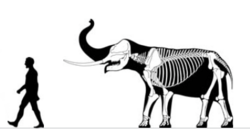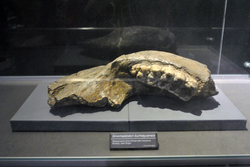Biology:Sinomastodon
| Sinomastodon | |
|---|---|

| |
| Skeletal restoration | |
| Scientific classification | |
| Domain: | Eukaryota |
| Kingdom: | Animalia |
| Phylum: | Chordata |
| Class: | Mammalia |
| Order: | Proboscidea |
| Family: | †Gomphotheriidae |
| Genus: | †Sinomastodon Tobien et al., 1986 |
| Type species | |
| †Sinomastodon intermedius Tobien et al., 1986
| |
| Species | |
| |
Sinomastodon ("Chinese mastodont") is an extinct gomphothere genus (of order Proboscidea) known from the Late Miocene to Early Pleistocene of Asia, including China, Japan, Thailand, Myanmar, Indonesia and probably Kashmir.[1]
Description
Sinomastodon, in comparison to earlier gomphotheres, had a shortened (brevirostrine) lower jaw that lacked permanent tusks/incisors. The skull was proportionally relatively short. The upper tusks, which are circular in cross-section, are upward curving and lack enamel bands. The molar teeth were triolophodont and bunodont.[2] One individual of S. hanjiangensis, suggested to about 30-years-old, is estimated to have been about 2.07 metres (6.8 ft) tall and weighed 2.1 tonnes (2.1 long tons; 2.3 short tons).[3]
Taxonomy and evolution
The taxonomic position of Sinomastodon is disputed. Some authors suggest that Sinomastodon originated from North American gomphotheres that migrated into Asia. Position according to Mothé et al. 2016 supporting this hypothesis, showing Sinomastodon nested amongst North American gomphotheres:[4]
†Gomphotheriidae (Gomphotheres)
|
| ||||||||||||||||||||||||||||||||||||||||||
However, the teeth of the earliest Sinomastodon species from the Late Miocene are zygodont, a morphology unknown in North American gomphotheres. Therefore is it is alternatively suggested that it derived from an Asian species of Gomphotherium, such as G. subtapiroideum or G. wimani.[5] The earliest members of the genus appear during the Late Miocene,[5] while the youngest members are known from the end of the Early Pleistocene, around 800,000 years ago.[6]
Diet
Specimens of Sinomastodon from the Early Pleistocene of South China (S. jiangnanensis, S. yangziensis) are suggested to have had browsing diet based on dental microwear analysis,[7] while Sinomastodon bumiajuensis from the Early Pleistocene of Java is suggested based on stable carbon isotope analysis to have been a variable feeder, with the majority of specimens found to have a predominantly grazing diet.[8]
References
- ↑ Parray, Khursheed A.; Jukar, Advait M.; Paul, Abdul Qayoom; Ahmad, Ishfaq; Patnaik, Rajeev (March 2022). Silcox, Mary. ed. "A gomphothere (Mammalia, Proboscidea) from the Quaternary of the Kashmir Valley, India" (in en). Papers in Palaeontology 8 (2). doi:10.1002/spp2.1427. ISSN 2056-2799. Bibcode: 2022PPal....8E1427P. https://onlinelibrary.wiley.com/doi/10.1002/spp2.1427.
- ↑ Wang, Yuan; Jin, ChangZhu; Deng, ChengLong; Wei, GuangBiao; Yan, YaLing (December 2012). "The first Sinomastodon (Gomphotheriidae, Proboscidea) skull from the Quaternary in China" (in en). Chinese Science Bulletin 57 (36): 4726–4734. doi:10.1007/s11434-012-5519-y. ISSN 1001-6538. Bibcode: 2012ChSBu..57.4726W.
- ↑ Larramendi, A. (2016). "Shoulder height, body mass and shape of proboscideans". Acta Palaeontologica Polonica 61. doi:10.4202/app.00136.2014. https://www.app.pan.pl/archive/published/app61/app001362014.pdf.
- ↑ Mothé, Dimila; Ferretti, Marco P.; Avilla, Leonardo S. (12 January 2016). "The Dance of Tusks: Rediscovery of Lower Incisors in the Pan-American Proboscidean Cuvieronius hyodon Revises Incisor Evolution in Elephantimorpha". PLOS ONE 11 (1): e0147009. doi:10.1371/journal.pone.0147009. PMID 26756209. Bibcode: 2016PLoSO..1147009M.
- ↑ 5.0 5.1 Wang, Shi-Qi; Ji, Xue-Ping; Jablonski, Nina G.; Su, Denise F.; Ge, Jun-Yi; Ding, Chang-Fen; Yu, Teng-Song; Li, Wen-Qi et al. (June 2016). "The Oldest Cranium of Sinomastodon (Proboscidea, Gomphotheriidae), Discovered in the Uppermost Miocene of Southwestern China: Implications for the Origin and Migration of This Taxon" (in en). Journal of Mammalian Evolution 23 (2): 155–173. doi:10.1007/s10914-015-9311-z. ISSN 1064-7554. http://link.springer.com/10.1007/s10914-015-9311-z.
- ↑ Wang, Yuan; Jin, Chang-zhu; Mead, Jim I. (August 2014). "New remains of Sinomastodon yangziensis (Proboscidea, Gomphotheriidae) from Sanhe karst Cave, with discussion on the evolution of Pleistocene Sinomastodon in South China" (in en). Quaternary International 339-340: 90–96. doi:10.1016/j.quaint.2013.03.006. Bibcode: 2014QuInt.339...90W. https://linkinghub.elsevier.com/retrieve/pii/S1040618213001390.
- ↑ Zhang, Hanwen; Wang, Yuan; Janis, Christine M.; Goodall, Robert H.; Purnell, Mark A. (26 July 2016). "An examination of feeding ecology in Pleistocene proboscideans from southern China (Sinomastodon, Stegodon, Elephas), by means of dental microwear texture analysis". Quaternary International 445: 60–70. doi:10.1016/j.quaint.2016.07.011. Bibcode: 2017QuInt.445...60Z.
- ↑ Puspaningrum, Mika R.; van den Bergh, Gerrit D.; Chivas, Allan R.; Setiabudi, Erick; Kurniawan, Iwan (January 2020). "Isotopic reconstruction of Proboscidean habitats and diets on Java since the Early Pleistocene: Implications for adaptation and extinction" (in en). Quaternary Science Reviews 228: 106007. doi:10.1016/j.quascirev.2019.106007. Bibcode: 2020QSRv..22806007P. https://linkinghub.elsevier.com/retrieve/pii/S0277379119303178.
- Tobien, H., Chen, G.F., and Li, Y.Q., 1986; Mastodons (Proboscidea, Mammalia) from the LateNeogene and Early Pleistocene of the People's Republic of China. Part I, HistoricalAccount. Mainzer geowiss, mitt., 15, pp. 119–181.
External links
Wikidata ☰ Q373271 entry
 |


